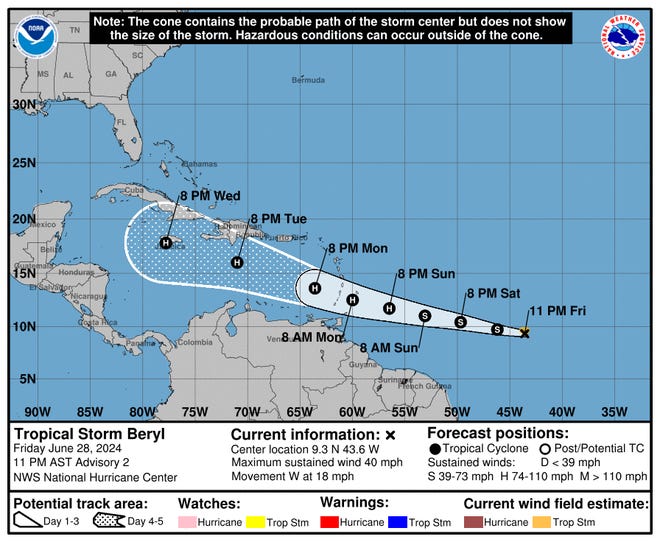Tropical Storm Beryl formed in the Atlantic Ocean east of the Windward Islands on Friday night and could move westward and become a hurricane called Beryl by Sunday, the National Hurricane Center said.
It is the second named storm of the 2024 Atlantic hurricane season and officially strengthened into a tropical storm about 1,100 miles southeast of the Windward Islands on the eastern edge of the Caribbean Sea.
The hurricane center said in an 11 p.m. alert that Beryl was moving at about 18 mph, with maximum sustained winds of 40 mph. Official forecasts said it was expected to become a hurricane by Sunday afternoon.
The storm was expected to move across the Windward Islands late Sunday into Monday morning, bringing heavy rain, hurricane-force winds and dangerous storm surges and waves. “Hurricane and tropical storm watches are likely to be in effect for parts of the Windward and southern Leeward Islands” on Saturday, the center said.
Barbados and nearby islands are expected to receive between 3 and 6 inches of rain, causing localized flooding in vulnerable areas as well as life-threatening high surf and low tides.
A Hurricane Hunter aircraft is expected to be deployed Sunday to survey the storm.

What’s the forecast for Beryl?
Meanwhile, people with interests in the central and western Caribbean should monitor the storm’s path, keeping in mind that forecast margins of error four to five days out can be substantial, the center recommended.
By the time Beryl moves into the Caribbean on Sunday evening, official forecasts say wind speeds could reach up to 105 mph. Atmospheric conditions at this time of year in June are typically not favorable for a storm to strengthen, but the center’s forecast description said some computer models are “fairly aggressive,” suggesting the storm could become a major hurricane before reaching the Windward Islands.
The center said models are still not in agreement on the hurricane’s path after it crosses the Caribbean, but as of now, official forecast cones show the storm’s center near or over the western half of the Dominican Republic and Haiti on Tuesday night, and over Jamaica or eastern Cuba on Wednesday night.
How rare are storms like Beryl’s?
The hurricane center said only a few storms in history have formed over the central or eastern tropical Atlantic at this time of year.
If it becomes a hurricane by Sunday afternoon, it will be the easternmost tropical Atlantic hurricane ever to form, breaking the record set in 1933, said Phil Klotzbach, a senior research scientist at Colorado State University and lead author of the seasonal hurricane forecast.
Tropical cyclone activity before Aug. 1 doesn’t correlate well with activity throughout the season, but early season activity east of the Lesser Antilles is generally associated with a very busy season, Klotzbach wrote in a post on X.

The new storm came a week after Tropical Storm Alberto slammed into northeastern Mexico, causing widespread flooding and killing at least four people, including three children. The storm also inundated Texas’ Gulf Coast, leaving the coastal city of Surfside Beach, south of Houston, under several feet of water.
Hurricane Tracking: The latest on every storm’s path
A system moving towards the Gulf of Mexico, a tropical wave in the Atlantic Ocean
Closer to the U.S., a low pressure system in the northwest Caribbean Sea is expected to move inland across the Yucatan Peninsula on Saturday. Conditions for further development are likely as the low pressure system moves into the Bay of Campeche in the southern Gulf of Mexico, the National Hurricane Center said Friday night. The center gave the system a 40% chance of further development within the next 48 hours.
Regardless of development, the system is forecast to bring rain and gusty winds to parts of Central America and Mexico through the weekend.
In the Atlantic Ocean, a tropical wave centered several hundred miles southwest of the Cape Verde Islands is producing rain and thunderstorms. The system may develop next week as it moves westward at 15 to 20 mph. There is a 40 percent chance that the system will develop further over the next seven days.
more:2024 Atlantic hurricane season storm names list kicks off with Alberto and Beryl
Experts predict busy hurricane season
Beryl is the latest storm to form in what is expected to be a above-normal tropical storm and hurricane.
In May, the National Oceanic and Atmospheric Administration predicted that this Atlantic hurricane season would see between 17 and 25 named storms, the most ever predicted by NOAA in a preseason forecast. According to NOAA, between 8 and 18 storms are expected to strengthen into hurricanes, with between 4 and 7 of those forecasted to become major hurricanes (Category 3, 4, or 5, with winds of 111 mph or more).
“All the conditions are in place for an active season,” National Weather Service Director Ken Graham said at a press conference in May. NOAA Administrator Rick Spinrad said the Atlantic hurricane season was shaping up to be “extraordinary,” with an 85 percent chance of above-normal weather.
The most named storms on record in a single season was 30, set in 2020. Based on weather records from 1991 to 2020, a typical year averages about 14 tropical storms, with seven of those developing into hurricanes.
Contributors: Doyle Rice, Gabe Haouari, USA Today; Cheryl McLeod, USA TODAY Network Florida

